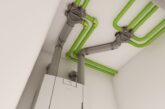
Builders can be presented with a unique set of challenges when insulating rainscreen façade systems. Bradley Hirst, Technical Services Manager from Knauf Insulation provides a checklist for achieving the best results.
Is it non-combustible? When choosing insulation for a rainscreen façade system, always start with fire safety. Building Regulations ban the use of combustible materials on all buildings over 18m in England and Wales and 11m in Scotland. But why take the risk? The safest option at any height is non-combustible insulation.
A Mineral Wool solution such as Rocksilk RainScreen Slab allows you to build with confidence – it is non-combustible with the best possible Euroclass A1 reaction to fire classification, and BBA certified for the widest range of thicknesses and build-ups on the market.
Does it achieve the correct U-value?
The build-up also needs to meet the thermal performance requirements. The complexity of rainscreen façade systems means that if there is no specific type of insulation specified or you want to substitute any part of the system, you should seek technical advice before construction. Ask for 3D U-value calculations to ensure the thermal requirements specified during design stage are achieved.
Does it reduce noise?
In low mass structures such as rainscreen façade systems, adding sound absorption helps reduce unwanted noise from passing through the system. Mineral Wool insulation has excellent sound absorbance properties, which contributes towards the acoustic performance of the building
How do you install insulation correctly?
Mineral Wool slabs should be butted tightly together and staggered to avoid coincidental joints to prevent unwanted air gaps that reduce thermal, fire and acoustic performance. Never overtighten mechanical fixings as this can compress and damage the insulation.
Are you following best practice for installation?
It’s best practice to co-ordinate trades so insulation and cladding are installed on a rolling front, rather than installing all the insulation then moving onto the cladding. This ensures the insulation is protected and is not exposed to the elements for any length of time.
For further information on the range of solutions available from Knauf Insulation visit https://www.knaufinsulation.co.uk/







